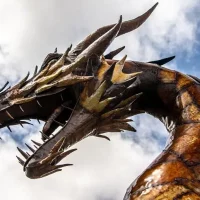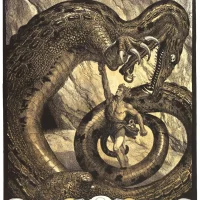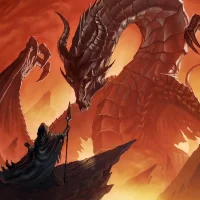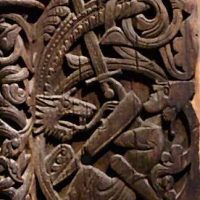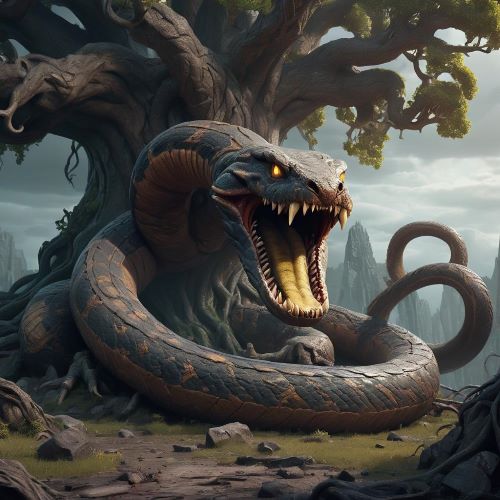Fafnir : The Greedy Dragon
Listen
At a glance
| Description | |
|---|---|
| Origin | Norse Mythology |
| Classification | Animals |
| Family Members | Hreiðmarr (Father), Regin and Ótr (Siblings) |
| Region | Iceland, Denmark, Finland |
| Associated With | Greed, Betrayal |
Fefnir
Introduction
Fafnir, a legendary figure from Norse mythology, is renowned for his dramatic metamorphosis from a human into a monstrous dragon. His saga, steeped in themes of greed, betrayal, and heroism, offers profound insights into the pitfalls of avarice and the valor of those who dare to defy it. Fafnir’s narrative, woven through epic poems and sagas, has left an enduring imprint on Norse folklore. Synonymous with greed and transformation, Fafnir occupies a pivotal role in Norse mythology, transcending mere dragon lore to embody timeless lessons about the corrupting influence of greed and the dire repercussions of yielding to its seductive allure.
Physical Traits
Before undergoing his transformation, Fafnir’s physical appearance remains shrouded in ambiguity within the Norse mythological texts. However, following his descent into greed and assuming the guise of a dragon, Fafnir is depicted as a formidable, flightless serpent-like being. In certain accounts, allusions are made to his having shoulders, potentially indicating the presence of either limbs or wings. Fafnir’s dragon form is emblematic of terror and power, aligning with the traditional portrayal of dragons in Norse lore as harbingers of chaos and devastation. Descriptions depict him with impenetrable iron-like scales, eyes ablaze with malevolence, and formidable claws and teeth capable of piercing through armor and flesh with ease. His breath is said to be lethal, striking down any who dare to oppose him.
Although depictions of Fafnir may vary, the prevailing image portrays him as a monstrous dragon, often referred to as a “worm” in ancient Norse texts. He is depicted as colossal, with scales so resilient that no weapon can penetrate them. While some narratives hint at the presence of wings, others emphasize his serpentine attributes. Despite these nuances, Fafnir consistently emerges as an imposing and formidable entity, epitomizing both the grave peril he represents and the immense treasure he fiercely safeguards.
Family
In the Völsung Cycle of Norse mythology, Fafnir emerges as the son of Hreiðmarr and the sibling of Regin and Ótr. His treacherous path unfolds when driven by insatiable greed, he slays his own father, seizing the ring and hoard of the dwarf Andvari. This ruthless act precipitates his metamorphosis into the fearsome dragon. Fafnir’s lineage intertwines with his monstrous transformation, underscoring the complexity of his character.
Born into the esteemed lineage of dwarves renowned for their craftsmanship and earthbound prowess, Fafnir’s familial ties encompassed his formidable father, Hreidmar, and his siblings, Regin, the adept blacksmith, and Otr, gifted with the ability to shift forms into an otter. This familial backdrop adds depth to Fafnir’s narrative, accentuating his tragic descent from a lineage esteemed for its skill and integrity, thus amplifying the profound tragedy of his transformation into a malevolent creature.
Other names
The name “Fáfnir” derives from Old Norse, signifying “the embracer.” He is alternatively referred to as Frænir in certain accounts, broadening the spectrum of his appellations. Within the annals of Norse literature, Fafnir assumes a variety of names, each imbued with unique nuances. In the revered Eddas, he is denoted as “Fáfnir,” while in the sagas of the Völsunga, he assumes the epithet “Ormr,” translating to “worm” or “serpent.” Furthermore, he occasionally adopts the title “Hnitathingr,” indicative of his dominion over Gnitaheath, a desolate expanse where he establishes his lair. These alternate designations offer diverse insights into Fafnir’s essence and his connections to specific locales within the tapestry of Norse mythology. The multiplicity of names associated with Fafnir underscores the multifaceted nature of his character, encapsulating facets ranging from his formidable demeanor to his familial bonds.
Powers and Abilities
As a dragon, Fafnir wields formidable strength and resilience, ensuring the protection of his coveted treasure. His transformation stems from the curse placed upon Andvari’s ring and gold, acquired through the patricidal act of slaying his own father. Fafnir’s draconic form manifests a formidable arsenal of abilities. His unparalleled might enables him to decimate entire armies with ease, while his impervious scales render him virtually invulnerable to all but the most potent of weapons. Moreover, Fafnir’s sagacity and cunning afford him the strategic advantage necessary to outmaneuver his adversaries and amass vast wealth.
His dragon guise embodies a relentless force, capable of overpowering and consuming any who dare challenge him. Some accounts suggest he commands the power to breathe fire, heightening the peril he poses. Yet, his most potent capability transcends mere physical prowess. Bound to the cursed gold, initially ensorcelled by the god Odin, Fafnir succumbs to its insidious influence, consumed by an insatiable greed that corrodes his very being. Thus, the tumultuous struggle between Fafnir’s formidable might and the corrupting allure of the cursed treasure forms a central motif within his narrative.
Modern Day Influence
Fafnir’s narrative reverberates through modern artistic expressions, notably influencing the creations of renowned authors such as J.R.R. Tolkien. In Tolkien’s “The Hobbit,” the character Smaug draws substantial inspiration from the legendary dragon, embodying similar traits of hoarding vast treasures and ultimately meeting his demise at the hands of a courageous hero. This portrayal underscores Fafnir’s enduring impact on literature, as the motif of a valiant figure confronting a dragon to claim its riches remains a prevalent theme in fantasy literature. Moreover, Fafnir’s legacy extends beyond literature, permeating various aspects of popular culture. His iconic status is evident in video games, where titles like “The Elder Scrolls V: Skyrim” and “God of War” feature his presence. Across diverse mediums, Fafnir’s name evokes notions of power, peril, and the allure of forbidden wealth, captivating audiences with the timeless themes of greed, transformation, and the eternal struggle between good and evil.
Related Images
Frequently Asked Questions
What is lorem Ipsum?
I am text block. Click edit button to change this text. Lorem ipsum dolor sit amet, consectetur adipiscing elit. Ut elit tellus, luctus nec ullamcorper mattis, pulvinar dapibus leo.
What is lorem Ipsum?
I am text block. Click edit button to change this text. Lorem ipsum dolor sit amet, consectetur adipiscing elit. Ut elit tellus, luctus nec ullamcorper mattis, pulvinar dapibus leo.
What is lorem Ipsum?
I am text block. Click edit button to change this text. Lorem ipsum dolor sit amet, consectetur adipiscing elit. Ut elit tellus, luctus nec ullamcorper mattis, pulvinar dapibus leo.
What is lorem Ipsum?
I am text block. Click edit button to change this text. Lorem ipsum dolor sit amet, consectetur adipiscing elit. Ut elit tellus, luctus nec ullamcorper mattis, pulvinar dapibus leo.
What is lorem Ipsum?
I am text block. Click edit button to change this text. Lorem ipsum dolor sit amet, consectetur adipiscing elit. Ut elit tellus, luctus nec ullamcorper mattis, pulvinar dapibus leo.


